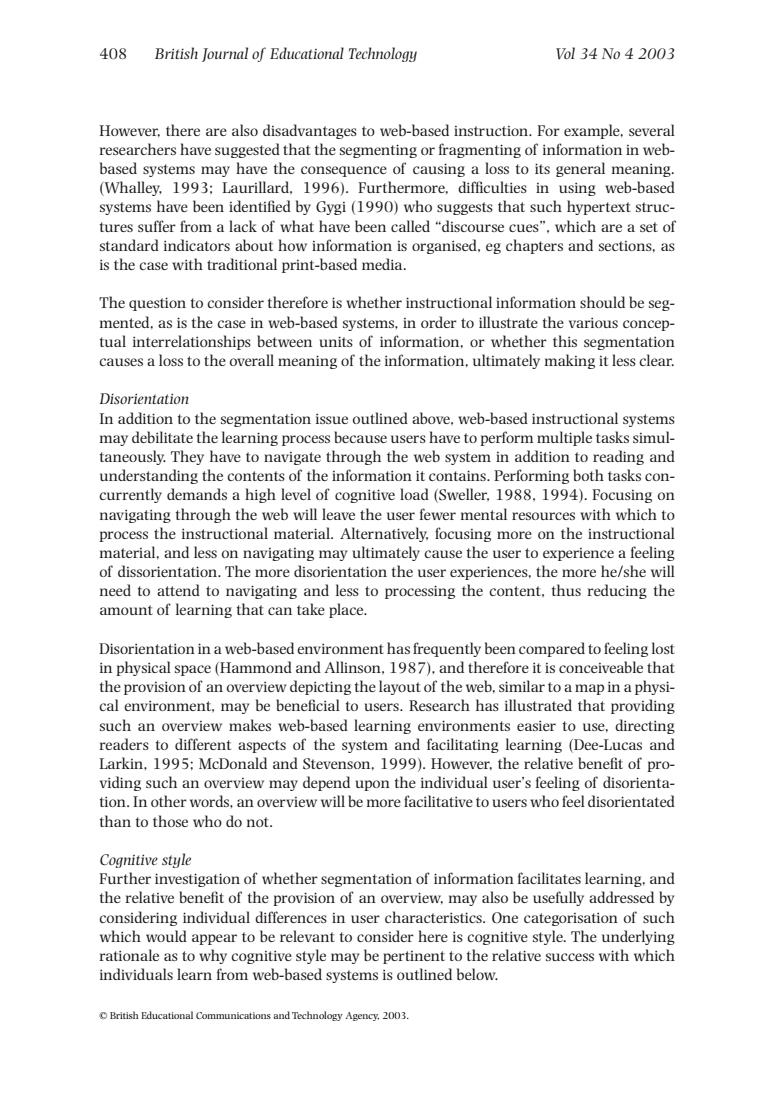正在加载图片...

408 British Journal of Educational Technology 7al34No42003 However.there are also disadvantages to web-based instruction.for example.several researchers have suggested that the segmenting or fragmenting of information in web based systems may have the consequence of causing a loss to its general meaning (Whalley.1993:Laurillard.1996).Furthermore.difficulties in using web-basec systems have been identified by Gygi()who sugests that such hypertext struc tures suffer from a lack of what h ve been called"di rse o cues",which are a set of standard indicators about how info mation is organised.eg chapters and sections,as is the case with traditional print-based media. The question to consider therefore is whether instructional information should be seg se in w veb-b .in order 。 ua I in elat p the this causes a loss toth overall meaning of the ely making It less clea Disorientation segmentation issue outlined abo ystems learning process le task ng and high leve onta 0 navigating through the web will m高 the user ver ment process the structional material.Alternatively.focus user to experien e a feeling of dissorientation.The more disori entation the user experiences.the more he/she wil need to attend to navigating and less to processing the content.thus reducing the amount of learning that can take place. Disorientation in a web-based environment has frequently been compared to feeling lost in physical space(Hammond and Allinson.1987).and therefore it is conceiveable that the provision of an overview depicting the layout of the web.similar to a map in a physi- cal environment.may be beneficial to users.Research has illustrated that providing such an overview makes web-based learning environments easier to use.directing readers to different aspects of the system and facilitating learning(Dee-Lucas and Larkin.1995:McDonald and Stevenson,1999).However.the relative benefit of pro- viding such an overview may depend upon the individual user's feeling of disorienta- tion.In other words.an overview will be more facilitative to users who feel disorientated than to those who do not. Cognitive style Further investigation of whether segmentation of information facilitates learning.and the relative benefit of the provision of an overview.may also be usefully addressed by considering individual differences in user characteristics.One categorisation of such which would appear to be relevant to consider here is cognitive style.The underlying rationale as to why cognitive style may be pertinent to the relative success with which individuals learn from web-based systems is outlined below.However, there are also disadvantages to web-based instruction. For example, several researchers have suggested that the segmenting or fragmenting of information in webbased systems may have the consequence of causing a loss to its general meaning. (Whalley, 1993; Laurillard, 1996). Furthermore, difficulties in using web-based systems have been identified by Gygi (1990) who suggests that such hypertext structures suffer from a lack of what have been called “discourse cues”, which are a set of standard indicators about how information is organised, eg chapters and sections, as is the case with traditional print-based media. The question to consider therefore is whether instructional information should be segmented, as is the case in web-based systems, in order to illustrate the various conceptual interrelationships between units of information, or whether this segmentation causes a loss to the overall meaning of the information, ultimately making it less clear. Disorientation In addition to the segmentation issue outlined above, web-based instructional systems may debilitate the learning process because users have to perform multiple tasks simultaneously. They have to navigate through the web system in addition to reading and understanding the contents of the information it contains. Performing both tasks concurrently demands a high level of cognitive load (Sweller, 1988, 1994). Focusing on navigating through the web will leave the user fewer mental resources with which to process the instructional material. Alternatively, focusing more on the instructional material, and less on navigating may ultimately cause the user to experience a feeling of dissorientation. The more disorientation the user experiences, the more he/she will need to attend to navigating and less to processing the content, thus reducing the amount of learning that can take place. Disorientation in a web-based environment has frequently been compared to feeling lost in physical space (Hammond and Allinson, 1987), and therefore it is conceiveable that the provision of an overview depicting the layout of the web, similar to a map in a physical environment, may be beneficial to users. Research has illustrated that providing such an overview makes web-based learning environments easier to use, directing readers to different aspects of the system and facilitating learning (Dee-Lucas and Larkin, 1995; McDonald and Stevenson, 1999). However, the relative benefit of providing such an overview may depend upon the individual user’s feeling of disorientation. In other words, an overview will be more facilitative to users who feel disorientated than to those who do not. Cognitive style Further investigation of whether segmentation of information facilitates learning, and the relative benefit of the provision of an overview, may also be usefully addressed by considering individual differences in user characteristics. One categorisation of such which would appear to be relevant to consider here is cognitive style. The underlying rationale as to why cognitive style may be pertinent to the relative success with which individuals learn from web-based systems is outlined below. 408 British Journal of Educational Technology Vol 34 No 4 2003 © British Educational Communications and Technology Agency, 2003